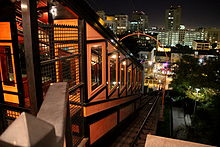
Charlestown is the oldest neighborhood in Boston, Massachusetts, in the United States. Also called Mishawum by the Massachusett, it is located on a peninsula north of the Charles River, across from downtown Boston, and also adjoins the Mystic River and Boston Harbor waterways. Charlestown was laid out in 1629 by engineer Thomas Graves, one of its earliest settlers, during the reign of Charles I of England. It was originally a separate town and the first capital of the Massachusetts Bay Colony.
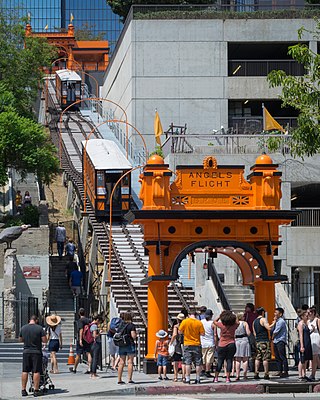
Angels Flight is a landmark and historic 2 ft 6 in narrow gauge funicular railway in the Bunker Hill district of Downtown Los Angeles, California. It has two funicular cars, named Olivet and Sinai, that run in opposite directions on a shared cable. The tracks cover a distance of 298 feet (91 m) over a vertical gain of 96 feet (29 m).

Downtown Los Angeles (DTLA) is the central business district of Los Angeles. It is part of the Central Los Angeles region and covers a 5.84 sq mi (15.1 km2) area. As of 2020, it contains over 500,000 jobs and has a population of roughly 85,000 residents, with an estimated daytime population of over 200,000 people prior to the COVID-19 pandemic. Despite a business exodus from downtown Los Angeles since the COVID-19 pandemic, the district is evolving as a cultural center with the world's largest showcase of architecture designed by Frank Gehry.

Chinatown is a neighborhood in Downtown Los Angeles, California, that became a commercial center for Chinese and other Asian businesses in Central Los Angeles in 1938. The area includes restaurants, shops, and art galleries, but also has a residential neighborhood with a low-income, aging population of about 7,800 residents.

Century City is a 176-acre neighborhood and business district in Los Angeles, California, United States. Located on the Westside to the south of Santa Monica Boulevard around 10 miles (16 km) west of Downtown Los Angeles, Century City is one of the most prominent employment centers in the Los Angeles metropolitan area, and its skyscrapers form a distinctive skyline on the city's westside.
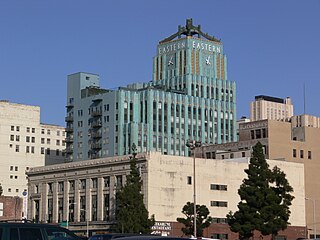
The Historic Core is a district within Downtown Los Angeles that includes the world's largest concentration of movie palaces, former large department stores, and office towers, all built chiefly between 1907 and 1931. Within it lie the Broadway Theater District and the Spring Street historic financial district, and in its west it overlaps with the Jewelry District and in its east with Skid Row.

The Civic Center neighborhood of Los Angeles, California, is the administrative core of the City of Los Angeles, County of Los Angeles, and a complex of city, county, state, and federal government offices, buildings, and courthouses. It is located on the site of the former business district of the city during the 1880s and 1890s, since mostly-demolished.

Wilshire Boulevard (['wɪɫ.ʃɚ]) is a prominent 15.83 mi (25.48 km) boulevard in the Los Angeles area of Southern California, extending from Ocean Avenue in the city of Santa Monica east to Grand Avenue in the Financial District of downtown Los Angeles. One of the principal east–west arterial roads of Los Angeles, it is also one of the major city streets through the city of Beverly Hills. Wilshire Boulevard runs roughly parallel to Santa Monica Boulevard from Santa Monica to the west boundary of Beverly Hills. From the east boundary, it runs a block south of Sixth Street to its terminus.
Central Los Angeles is the historical urban region of the City of Los Angeles, California.
The Grand Avenue Project was a government lead revitalization effort for the Bunker Hill neighborhood of Downtown Los Angeles on Grand Avenue and centered around Grand Park, its surrounding county government buildings and its parking lots. It was administered by the Grand Avenue Authority, a joint powers authority consisting of Los Angeles County and City. The first task was to improve the streetscape of Grand Avenue. The second element was to upgrade the 12-acre (4.9 ha) Grand Park in 2012 with a refurbished fountains, lawn furniture, walkways and the planting of native gardens. And lastly, constructing several residential buildings, including a two-tower complex on the southeast corner of Grand Avenue and 1st Street, designed by Frank Gehry.

Prudent Beaudry was a Canadian-born American politician who served as the 13th mayor of Los Angeles, from 1874 to 1876. A native of Quebec, he was the 2nd French Canadian and 3rd French-American mayor of Los Angeles.

Cypress Park is a densely populated neighborhood of 10,000+ residents in Northeast Los Angeles, California. Surrounded by hills on three sides, it sits in the valley created by the Los Angeles River and the Arroyo Seco. It is the site of the Rio de Los Angeles State Park, the Los Angeles River Bike Path and other recreational facilities. It hosts one private and four public schools.

Skid Row is a neighborhood in Downtown Los Angeles. The area is officially known as Central City East.
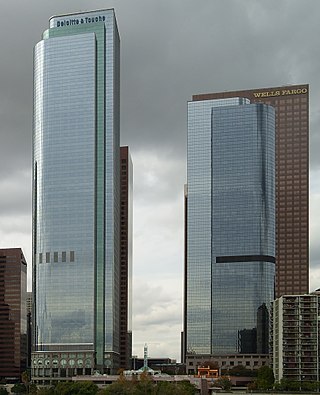
2Cal, formerly known as Two California Plaza, is a 750-foot (230 m) skyscraper in the Bunker Hill District of downtown Los Angeles, California, United States. The tower is part of the California Plaza project, consisting of two unique skyscrapers, One California Plaza and Two California Plaza. The Plaza is also home to the Los Angeles Museum of Contemporary Art (MoCA), Colburn School of Performing Arts, the Los Angeles Omni Hotel, and a 1.5-acre (0.61 ha) water court.
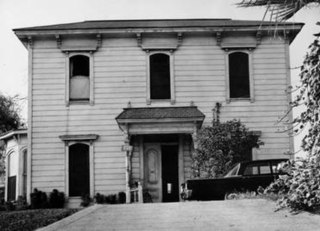
The Salt Box was a house built in the early 1880s in the Bunker Hill section of Los Angeles, California. Designed in the saltbox style that was popularized in New England, it was originally located at 339 South Bunker Hill Avenue. It was the home of physician Dr. A.G. Cook for most of the 1880s. In the late 19th century, Bunker Hill was one of the most prestigious neighborhoods in Los Angeles and was the site of many elegant Victorian homes. The Los Angeles Times wrote of old Bunker Hill: "Nowhere else in Los Angeles was the architecture so ornate. The mansions were wooden-frame Victorian with Gothic gingerbread touches applied with a heavy hand to simulate masonry." Though not as elegant as many of its Victorian neighbors, the Salt Box was "cherished by architecture students for the simplicity of its design."

The Hotel Alexandria is a historic building constructed as a luxury hotel at the beginning of the 20th century in what was then the heart of downtown Los Angeles. As the business center of the city moved gradually westward, the hotel decayed and gradually devolved into a single-room occupancy (SRO) hotel housing long-term, low income residents and gained a reputation for crime and being unsafe. Revitalization of the area in the 21st century changed the rental practices and neighborhood safety.
Grand Avenue is a major north–south thoroughfare in Los Angeles, California. Primarily located in downtown's Bunker Hill, Financial, and South Park districts, the avenue features many of the area's most notable destinations, and also connects to City Hall via Grand Park.

Central City West, sometimes known as City West or The West Bank, is a neighborhood in Downtown Los Angeles.
Angels Landing is a proposed development complex in Downtown Los Angeles, California, consisting of two traditional high-rise buildings.
Victor Heights, sometimes referred to as the Forgotten Edge, is a neighborhood in Central Los Angeles.








